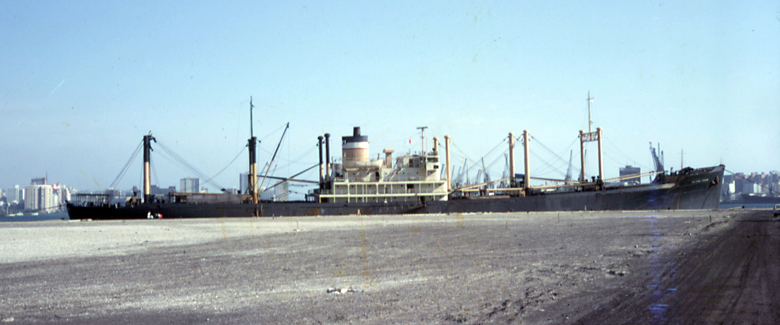
A few weeks ago I highlighted my months in the American Merchant Marine leading up to our wedding. Today I'm continuing the story to the completion of my involvement with ocean-going merchant ships.
The honeymoon ended when I was ordered aboard American Export Isbrandtsen Lines' SS Flying Foam in New York City. I actually have a picture of that illustrious old cargo ship. I don't know where she was docked when I took it, but I present it to you above. It's classified as a C3 cargo ship probably about 450 feet long. There are 3 hatches forward of the superstructure and 2 hatches aft. The crew numbered between 45 and 50 men. On October 23, 1967, we sailed from New York headed for India and East and West Pakistan.
Since the Suez Canal was still closed and would be for another 7 or 8 years, we sailed around the southern tip of Africa; the Cape of Good Hope. We stopped in Durban to get vaccinated against whatever plague was running wild in India at that time. What I recall mostly is taking the crew to get their shots and having to be aware of apartheid in South Africa. The crew was mostly black or hispanic. The place where the vaccinations were given was a large room with 2 doors; one for whites and the other for Africans. I had 1 hispanic kid who refused to go through either door and didn't get vaccinated. The doctor even volunteered to administer the shot in the hall, but the kid refused. I think he was afraid of the needle more than anything else. So for the rest of the voyage, he was quarantined to the ship, and since he was on my watch, I had to insure that he didn't leave the ship. Funny thing is I still remember his name. But I called him Eye-useless.
We sailed into the Indian Ocean headed for Bombay (now Mumbai) India and Karachi in what was then called West Pakistan. Two memories: In Bombay one couldn't drink alcohol without a permit, and you couldn't get a permit without bribing the government official issuing the permits. And we spent Christmas in Karachi where the temperature dropped overnight into the 50s causing me to wear long underwear under my uniform and P-coat. We docked in other notable ports-of-call like Madras (now Chennai), Colombo (in Sri Lanka), Visahapatnam (my fav), and Chittagong in East Pakistan (now Bangladesh). We returned home, retracing our steps around South Africa, in early March. After a couple weeks off, we set sail once again around Africa into the Indian Ocean and the Bay of Bengal revisiting all those wonderful places.
One of the more interesting aspects of those two voyages was the number of books I read. Before leaving the States I bought dozens of paperbacks. The complete works of Charles Dickens is an example. In each port book dealers would come aboard the ship to sell or trade books with the crew members. Now I had this paperback that was a history of the Crusades. Yes, I read history books too. But the cover of that book depicted a knight on horseback rescuing a damsel in distress (I guess). I remember the low-cut dress. I offered that book to a book dealer in some Indian port, and we spent a few minutes haggling over its worth. He finally offered 4 of his best books for my history book. Thus proving that famous saying, "It pays to be literate!"
I returned home, for good, on August 28, 1968. There are many other interesting stories from those 2 trips. The birds and the feral dogs. The mongoose and the cobra. The nuns barging into my room without knocking looking for a donation and what I was doing when they opened the door. The guy chanting prayers outside my porthole who wouldn't stop. Maybe another time.